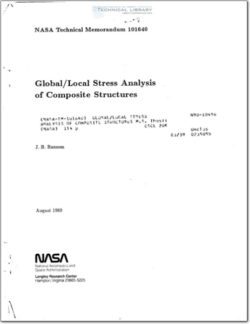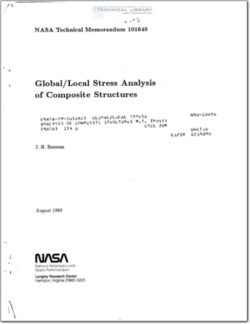NASA-TM-101640

- Version
- 189 Downloads
- 3.88 MB File Size
- 1 File Count
- December 13, 2015 Create Date
- December 13, 2015 Last Updated
Global-Local Stress Analysis of Composite Structures

Discontinuities and eccentricities, which are common in practical structures,
increase the difficulty in predicting accurately detailed local stress distributions,
especially when the component is built of a composite material, such as a graphite—
epoxy material. The use of composite materials in the design of aircraft structures
introduces added complexity due to the nature of the material systems and the
complexity of the failure modes. The design and certification process for aerospace
structures requires an accurate stress analysis capability. Detailed stress analyses of
complex aircraft structures and their subcomponents are required and can severely
tax even today’s computing resources. Embedding detailed “local” finite element
models within a single “global” finite element model of an entire airframe structure
may be impractical due to the computational cost associated with the large num-
ber of degrees of freedom required for such a global detailed model. If the design
load envelope of the structural component is extended, new regions with high stress
gradients may be discovered. In that case, the entire analysis with embedded local
refinements may have to be repeated and thereby further reducing the practicality
of this brute force appro'ach'far’obtamiig the detailed ”stress state. Adaptive mesh
refinement methods may be used to embed the local refinement in the global finite
element model. The increased number of degrees of freedom again reduces the prac-
ticality of this approach in the global/local analysis realm. Also in structural appli-
cations, triangular elements introduced through unstructured rerneshing methods
may adversely affect the solution because they are inherently stifl'er than quadri-
lateral elements, and hence may require a more complicated structured remeshing
method.
The phrase global/local analysis has a myriad of definitions among analysts.
The concept of global and local may change with every analysis level, and also from
one analyst to another (see Fig. 1.1). An analyst may consider the entire aircraft
structure to be the global model, and a fuselage section to be the local model. At
another level, the fuselage or wing may be the global model, and a. stiffened panel is
the local model. Laminate theory is used by some analysts to represent the global
model, and micromechanics,models are used for the local model. At the materials
level, global/local variational models (e.g., refs. [1, 2]) may be used to define detailed
response functions in a particular, predetermined local region of interest, while
the remainder of the global domain may be represented by effective properties.
The global—local model is developed to examine the elastic stress field in laminates
containing many layers.
| File | Action |
|---|---|
| NASA-TM-101640 Global-Local Stress Analysis of Composite Structures.pdf | Download |

Comment On This Post